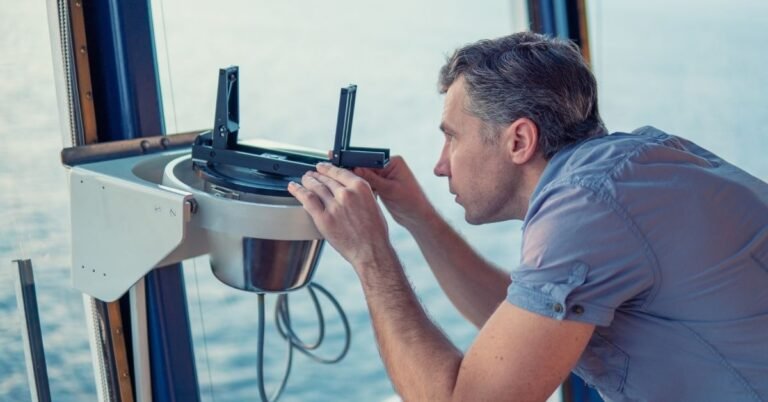The maritime world is witnessing tremendous strides in technological advancements, with new digital onboard systems, automation, and AI making operations smoother, precise and safer for seafarers as well as port authorities. However, the majority of the basic maritime technologies on which the current systems are based trace their origins to past centuries. Some of these old technologies, which are still relevant today, will be discussed in this article.
1. The Magnetic Compass
All modern ships feature GPS Systems to accurately locate a ship’s position; however, the magnetic compass remains a vital equipment on every ship.
Though the principle on which a compass works was understood for centuries, its refinement and adoption as a trustworthy navigational tool for long sea voyages became widespread in the late 19th and 20th centuries.
A magnetised needle, free to rotate, aligns itself with the Earth’s magnetic field, pointing to the magnetic north. The compasses of the early 20th century were damped in liquid to prevent erratic swings and needed careful calibration to compensate for the vessel’s own magnetic influences.
The magnetic compass is independent from any power sources or signals and can act as a backup in case of power failures, cyberattacks on ships or a GPS signal loss. Every ship’s bridge features a standard magnetic compass, often located on the monkey island above, for taking bearings.
2. The Anchor
The concept of the anchor is as old as seafaring, though the anchor design and the material used for its construction have evolved significantly in the past 100 years.
By the 20th century, the stockless anchor, which was patented in the 19th century, was adopted and became the most common for large ships due to the ease of housing in the hawse pipe.
The anchor is used to secure a ship to the seafloor and prevent it from drifting due to the power of winds and strong waves. The anchor’s weight, along with the design of its flukes, enables it to dig into the seabed while the anchor chain or cable connects it to the vessel, preventing the ship from moving or drifting from its position.

There have been advancements in dynamic positioning systems, which are automated systems that use thrusters and propellers to maintain a ship’s position without the need for traditional anchors or mooring. They are crucial for offshore operations; however, anchors remain the most reliable for securing ships in harbours, anchorages and roadsteads.
This is due to their simple yet effective functioning, which makes them significant. They also don’t need any power output. Modern ship anchors, though refined in terms of material and fluke design, operate on the same principle as their 20th-century counterparts.
3. The Rudder and Steering Gear
Though thrusters and azimuth pods are common nowadays, steering a ship using a rudder and associated gear dates back millennia.
By the 20th century, steam and then electric-powered steering gear replaced manual systems on bigger ships, making steering less labour-intensive.
The rudder is a flat or hydrofoil-shaped appendage at the stern that is pivoted to deflect the flow of water passing the hull. The deflection generates a force that pushes the stern sideways, causing the bow to turn in the opposite direction.

The 20th-century steering gear used steam engines or electric motors to turn the rudder back using a worm gear or hydraulic system that was controlled from the bridge.
Today, even ships with advanced propulsion systems rely on a rudder or integrated thruster-rudders for precise steering and course keeping.
The basic hydrodynamic principles remain unchanged, and the mechanical and hydraulic systems for transmitting steering commands from the bridge to the rudder are quite similar, albeit with electronic controls.
4. Marine Chronometer
The marine chronometer is a highly accurate and stable timekeeping device which has changed celestial navigation.
Though John Harrison developed the first practical chronometers in the 18th century, their widespread use in merchant ships and naval vessels increased in the 19th and 20th centuries, making precise longitude determination at sea a greater possibility.

The chronometer, by keeping extremely accurate time, enabled navigators to calculate their longitude by observing the precise time of celestial events like a star’s median passage at their location and comparing it to the known Greenwich Mean Time of that event. Even the smallest errors in timekeeping could lead to major errors in longitude.
Though GPS has overtaken celestial navigation, the underlying principle of precise timekeeping remains paramount. GPS relies heavily on atomic clocks to offer incredibly accurate time signals.
On ships, accurate chronometers or time synchronisation systems are vital for several operations, including communications, backup navigation, and data logging, in case electronic systems fail.
5. Whistles and Horns
The use of sound signals to communicate and warn of hazards has been a part of seafaring for centuries.
However, the method has evolved a lot.
By the 20th century, steam whistles and later electric horns were standard and powerful for avoiding collisions between ships and signalling, governed by increasingly codified ‘Rules of the Road’, now the International Regulations for Preventing Collisions at Sea – COLREGs.
Sound signals are used to convey a ship’s manoeuvre, e.g turning to starboard, astern propulsion, its inability to manoeuvre at anchor or to warn of danger in case there is limited visibility.
Though there are radars, AIS systems and VHF radios for communication, sound signals are a legally required means of communication at sea, especially in conditions of restricted visibility, eg fog, heavy rain, etc, where visual contact is lost or electronic systems cannot be relied on. They are an immediate and universally understood method of communication.
These technologies mentioned above have evolved over centuries and highlight the power of robust design and fundamental principles. They are a powerful reminder that, though technology pushes forward, the most important innovation underpins the very essence of maritime safety and efficiency, proving their worth across a century of dynamic changes.

